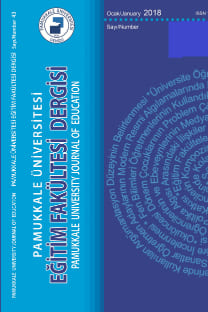5. Sınıf Madde ve Değişim Ünitesi Kapsamında Hazırlanan Senaryoların Merak Edilme Düzeyinin Cinsiyete Göre Değişimi
Beşinci sınıf öğrencileri, madde ve değişim, merak
Effect of Gender on Levels of Curiosity towards Scenarios Prepared within the Scope of the “Matter and Change” Unit at the 5th Grade
5th grade students curiosity, matter and change, PBL and scenarios,
___
- Baser, M., & Geban, O. (2007). Effectiveness of conceptual change instruction on understanding of heat and temperature concepts. Research in Science & Technological Education, 25(1), 115–133.
- Campbell, J.R. (1972). “Is scientific curiosity a viable outcome in today's secondary school science program?” School Science and Mathematics, 72 (2), 139-147.
- Campbell, R.J. (2000). The development and validation of an instructional design model for creating problem based learning. Dissertation Abstracts International, 61(01), 67A (UMI No: 9957710).
- Canpolat, N. (2006). Turkish undergraduates’ misconceptions of evaporation, evaporation rate, and vapour pressure. International Journal of Science Education, 28(15), 1757–1770.
- Canpolat, N., Pınarbası, T., & Sozbilir, M. (2006). Prospective teachers’ misconce- options of vaporization and vapor pressure. Journal of Chemical Education, 83(8), 1237–1242.
- Carlin, K.A. (1999). The impact of curiosity on learning during a school field trip to the zoo. Dissertation Abstracts International, 60 (09), 3253A. (UMI No. 9945941)
- Carlton, K. (2000). Teaching about heat and temperature. Physics Education, 35(2), 101-105.
- Cerezo, N.A. (2000). Problem-based learning in the middle school: Perception of at risk females and their teachers. Dissertation Abstracts Internatinal, 61(02), 475A. (UMI No: 9958903).
- Chang, J.Y. (1999). Teachers college students’ conceptions about evaporation, condensation, and boiling. Science Education, 83, 511–526.
- Conger, A. (2001). Problem based science learning in a mixed ability classroom that includes gifted and talented children. Master’s Abstracts International, 39 (03), 644. (UMI No: 1402664).
- Costu, B., & Ayas, A. (2005). Evaporation in different liquids: Secondary students’ conceptions. Research in Science & Technological Education, 23(1), 75-97.
- Duch, B.J. (2007). Problem-based learning. University of Delaware, http://www.udel.edu/pbl/ (accessed December 20, 2010).
- Duch, B.J., Groh, S. E., & Allen, D. E. (2001). Why problem-based learning? A case study of institutional change in undergraduate education. The power of problem-based learning, Ed. Barbara J. Duch, Susan E. Groh, and Deborah E. Allen, 3-11. Sterling, Virginia: Stylus.
- Gopal, H., Kleinsmidt, J., Case, J., & Musonge, P. (2004). An investigation of tertiary students’ understanding of evaporation, condensation and vapor pressure. International Journal of Science Education, 26, 1597–1620.
- Harty, H., & Beall, D. (1984). “Toward the development of a children’s science curiosity measure”. Journal of Research in Science Teaching, 21 (4), 425-436.
- Harty, H., Beall, D., & Scharmann, L. (1985). Relationships between elementary school students’ science achievement and their attitudes toward science, interest in science, reactive curiosity, and scholastic aptitude. School Science and Mathematics, 85 (6), 472-479.
- Johnson, P. (1998). Children’s understandings of changes of state involving the gas state, part 2: Evaporation and condensation below boiling point. International Journal of Science Education, 20(6), 695–709.
- McMillan, J. H., & Schumacher, S. (2010). Research in education: Evidence-based inquiry (seventh edition). Boston: Pearson
- Pınarbası, T., & Canpolat, N. (2003). Students’ understanding of solution chemistry concepts. Journal of Chemical Education, 80, 1328-1332.
- Savery, J.R. (2006). Overview of problem-based learning: Definitions and distinctions. The Interdisciplinary Journal of Problem-Based Learning, 1(1), 9–20.
- Sonmez, D. & Lee H. (2003). Problem-based learning in science. ERIC Clearinghouse for Science, Mathematics and Environmental Education, ERIC Digest ED-SE–03–04,1–2.
- Zacharias C. Z., Georgios, O., & Marios, P. (2008). Effects of experimenting with physical and virtual manipulatives on students’. conceptual understanding in heat and temperature. Journal of Research in Scıence Teaching, 45(9), 1021-1035.
- ISSN: 1301-0085
- Yayın Aralığı: 3
- Başlangıç: 1996
- Yayıncı: -
Öğretmen Adaylarının Eleştirel Düşünmeye İlişkin Tutumlarının Çeşitli Değişkenlere Göre İncelenmesi
Nevin AKKAYA, Cenan İŞÇİ, Fatma SUSAR KIRMIZI
Ortaokul Öğrencilerinin Eleştirel Düşünme ve İletişim Becerileri
Türkiye’de Okul Yöneticisi Görevlendirme Sorunu: Bir Meta Sentez Çalışması
Osman Tayyar Çelik, Necdet Konan, Remzi ÇETİN
Türkiye’de Psikolojik Danışmanlık ve Rehberlik Öğrencilerinin Etik İnanışları
Ümüt ARSLAN, John SOMMERS-FLANAGAN
Elif ÖZATA YÜCEL, Muhlis ÖZKAN
Görsel Sanatlar Eğitiminde Bellek Eğitimi Yönteminin Öğrencilerin Stereotip Bitki Çizimlerine Etkisi
Taylan GÜVENİLİR, Meliha YILMAZ
Ortaokul 6. Sınıf Öğrencilerinin Sistem Düşünme Becerilerine İlişkin Durumlarının Belirlenmesi
